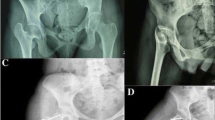Summary
Experimentally induced subcapital Pauwels III femoral neck fractures with human cadaveric material have been treated with ten different kinds of internal fixation and examined as to their mechanical resistance by statical means. Solid nails with additional fixation to the subtrochanteric area are superior to those without fixation. Similar positive results have been obtained using sliding nails. Multiple fixation revealed marked elasticity. As an index for stability the deviation of the femoral head during and after exposition to weight bearing of well defined doses was recorded. From the numeric results we draw the conclusion that the examined types of internal fixation may tolerate the stress from body weight in standing position, but not with the patient walking.
Résumé
Aprés avoir fixé des fractures de forme sous-capitale du col du fémur d'aprés Pauwels III, on a procédé à des essais de charge statique sur dix matériaux différents d'ostéosynthèse dans un os de cadavre. Il est évident que les clous solides avec fixation au fémur sont meilleurs que ceux sans fixation. Les clous glissants donnent également de bons résultats. Les fixations multiples se révèlent par leur haute élasticité. Comme indice de stabilité on a pris la déviation de la tête fémorale pendant et aprés certaines charges. D'aprés ces résultats on peut conclure que toutes les méthodes de fixations examinées supportent la charge lorsque le malade est debout, mais non quand il marche.
Zusammenfassung
Es wurden insgesamt zehn verschiedene Osteosynthesematerialien am Leichenknochen statischen Belastungsversuchen unterzogen, nachdem subkapitale glattrandige Schenkelhalsfrakturen nach Pauwels III gesetzt worden waren. Starre Nägel mit Verankerung am Oberschenkelschaft sind solchen ohne Verankerung deutlich überlegen. Ebenso günstig verhalten sich Gleitnägel. Multiple Fixationen zeichnen sich durch hohe Elastizität aus. Als Index für die Stabilität galt die in 1/100 mm gemessene Kopfabweichung während und nach dosierten Belastungen. Auf Grund der Meßwerte ist zu erwarten, daß alle geprüften Fixationsmethoden den Belastungen im Stand gewachsen sind, nicht jedoch denjenigen beim Gang.
Similar content being viewed by others
Literatur
Frankel, V. H.: The femoral neck. An experimental study of function, fracture mechanism and internal fixation. Uppsala: Almqvist & Wiksells 1960.
Hackstock, H., u. M. H. Hackenbroch jun.: Stabilitätsuntersuchungen verschiedener Osteosynthesematerialien beim Schenkelhalsbruch. (Vortrag 3. Kongreß der Österreichischen Gesellschaft für Unfallchirurgie, Salzburg 1967.) Hefte zur Unfallheilkunde 97, 53–55 (1968).
Pauwels, F.: Gesammelte Abhandlungen zur funktionellen Anatomie des Bewegungsapparates. Berlin-Heidelberg-New York: Springer 1965.
Author information
Authors and Affiliations
Additional information
Herrn Professor Dr. Jörg Böhler zum 50. Geburtstag gewidmet.
Rights and permissions
About this article
Cite this article
Hackstock, H., Hackenbroch, M.H. Verschiedene Fixationsmethoden des Schenkelhalsbruchs im statischen Belastungsversuch. Arch orthop Unfall-Chir 66, 72–80 (1969). https://doi.org/10.1007/BF00419119
Received:
Issue Date:
DOI: https://doi.org/10.1007/BF00419119




